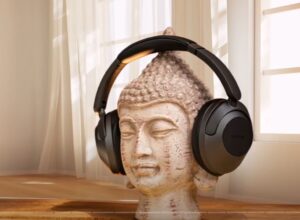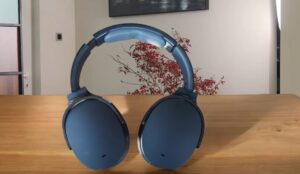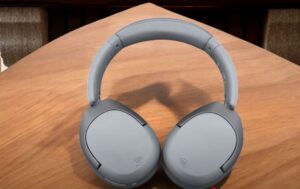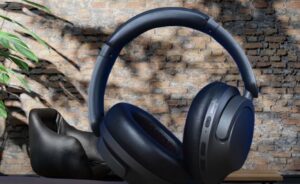Can You Still Hear Everything with Noise Cancelling Headphones?
Headphones people first try out noise cancelling headphones, they are often amazed by the quiet they create.
In a world full of constant background noise from the low hum of an airplane engine to the chatter in a busy office the idea of a switch that can simply turn off sound is incredibly appealing.
This leads to a common question: do these headphones completely block out all external noise, or do they just make it quieter?
The short answer is that no headphone can create a total vacuum of sound. But the technology is so effective at what it does that it can feel like magic. The reality is a fascinating blend of advanced headphone technology and the physical limitations of sound itself.
This guide will take you behind the curtain to explain exactly what you can, and cannot, hear while using noise-cancelling headphones.
We’ll clarify the difference between different types of sound blockage and set realistic expectations for what this amazing technology can do for your focus and peace of mind.
How Noise-Cancelling Technology Works
To understand what you can still hear, you first have to understand how active noise cancellation (ANC) works. It’s a process based on a simple, yet brilliant, scientific principle: destructive interference.
Imagine sound as a wave, with peaks and valleys. ANC headphones use a system of tiny microphones and a special processing chip to perform a kind of audio alchemy. The microphones, usually located on the outside of the headphone earcups, “listen” to the external noise around you.

The chip then analyzes this sound and, in a fraction of a second, creates an exact opposite sound wave one with the same volume but with its peaks where the original wave’s valleys are and vice versa. When these two opposing sound waves meet, they cancel each other out.
This process, known as sound wave cancellation, effectively eliminates the original sound before it ever reaches your ear.
This is the key difference between ANC and passive noise isolation.
- Passive Noise Isolation: This is the older, simpler form of noise reduction. It relies on the physical design of the headphones, such as the material of the earpads and the way they seal around your ears. Think of them as high-tech earmuffs. This acoustic design is very good at physically blocking out some sound, particularly high-frequency noises. It’s the reason that even a simple pair of well-fitting over-ear headphones can make a room feel quieter.
- Active Noise Cancellation (ANC): ANC is the more advanced technology that uses electronics to actively neutralize noise. While a good pair of ANC headphones will also have excellent passive isolation, the real magic happens with the active component. ANC is most effective at targeting consistent, low-frequency sounds. This is because these sounds have long, predictable wavelengths that are easy for the headphone’s chip to analyze, process, and cancel out. The low rumble of an airplane engine, the hum of an air conditioner, or the constant whir of a train are perfect targets for ANC.
By combining the physical barrier of passive noise isolation with the electronic cancellation of ANC, modern headphones can provide a comprehensive shield against most common background noises, creating a serene environment for listening or concentration.

Sounds You Can Still Hear with Noise-Cancelling Headphones
Despite the amazing abilities of ANC technology, there are certain types of sounds that it cannot completely eliminate. This is not a flaw in the product but a limitation of the technology and the physics of sound.
- High-Frequency Sounds: While ANC is a master of canceling out low-frequency noise, it is much less effective against high-frequency sounds. Sounds like a fire alarm, a ringing phone, or the sound of cymbals in a song can still cut through. This is because high-frequency sounds have short, complex, and unpredictable wavelengths. The ANC chip simply can’t process these rapid changes fast enough to generate a perfect canceling wave. This is a key reason why human speech frequencies are so hard to block out completely. The varied pitch, tone, and sudden starts and stops of a conversation make it a poor target for ANC. While ANC can reduce the volume of nearby chatter, it often won’t make it unintelligible, leading to a phenomenon where voices seem oddly more prominent when the background hum is gone.
- Sudden, Loud Noises: ANC technology works by “listening” to the sound first and then creating the counter-wave. This means there is a very small, but real, delay. For a sudden, loud noise like a handclap, a dog bark, or a car horn, the sound wave will have already passed before the headphone’s system can react and cancel it out. While the headphone’s passive isolation will muffle the sound, the loud, sharp noise will still be audible. This is a design choice that is often deliberate for environmental awareness and safety.
- Ambient Sound Leakage: The effectiveness of both passive and active noise cancellation depends on a good seal between the headphone and your head. If the earcups don’t fit snugly, some sound will “leak” in from around the seal. This ambient sound leakage can reduce the effectiveness of both ANC and passive isolation. This is also why an over-ear headphone with a poor fit will often perform worse than a well-fitting in-ear earbud. Additionally, some headphones have a “Transparency Mode,” which uses the microphones to purposely let external sounds in, ensuring you can hear announcements or have a conversation without taking off the headphones. While useful, it’s a feature that users need to be aware of to avoid thinking their headphones are not working properly.

In summary, while ANC headphones can feel like magic, they are not a perfect barrier. They are masters of creating a quiet background by erasing low-frequency sounds, but they are much less effective at completely blocking out sharp, unpredictable, and high-frequency sounds. Understanding these limitations is key to getting the most out of your headphones and appreciating the incredible headphone technology that makes them work.
Pros and Cons of Noise-Cancelling Headphones
While ANC headphones are a transformative piece of technology, they are not without their trade-offs. It’s important to weigh the benefits of ANC against the drawbacks of ANC to decide if they are the right choice for your lifestyle.
Pros
- Reduced Stress and Fatigue: Constant exposure to background noise, whether it’s from a plane engine or a bustling office, can be mentally draining. By creating a quiet environment, ANC headphones significantly reduce cognitive fatigue and stress, allowing you to feel more relaxed and refreshed.
- Better Focus: By eliminating auditory distractions, ANC headphones allow you to concentrate more effectively on tasks, whether you’re working, studying, or simply trying to read a book. This improved focus can lead to higher productivity and a deeper sense of immersion in your activities.
- Improved Audio Clarity: Without competing background noise, you no longer have to crank up the volume to hear your music, podcasts, or audiobooks. This not only protects your hearing but also allows you to enjoy a cleaner, richer sound with a noticeable audio quality improvement.
Cons
- May Block Out Helpful Alerts: A major drawback of using ANC headphones is that they can make you less aware of your surroundings. This can be a safety concern, as they might reduce the audibility of important sounds like car horns, alarms, or a person calling your name.
- Battery Drain: The active noise-cancellation technology requires power, which drains the battery faster than just playing audio. This means ANC headphones typically have a shorter battery life when the feature is enabled, and you need to remember to charge them more frequently.
- Higher Cost: The sophisticated technology required for effective ANC makes these headphones more expensive than standard non-ANC models. This can be a significant investment, especially for the top-tier products on the market.
FAQs
-
Can noise cancelling headphones block voices completely?
No, voices are harder to cancel because they are high-frequency sounds. -
Do ANC headphones work without music?
Yes, ANC works on its own, even in silent mode. -
Can you hear alarms with noise cancelling headphones on?
Most alarms are designed to cut through, so you will still hear them faintly. -
Is it safe to wear noise cancelling headphones while walking outside?
Use caution, since they reduce awareness of cars and people. Transparency mode helps. -
Do noise cancelling headphones cause total silence?
No, they reduce low-frequency sounds but do not eliminate all noise.
Conclusion
In the end, the most important takeaway is that ANC headphones are not magic sound blockers. They are an incredible piece of technology that works by intelligently canceling out specific types of noise, primarily the consistent, low-frequency sounds that cause the most fatigue. While they cannot create a total vacuum of sound, they can profoundly transform your acoustic environment for the better.
The choice of headphones should be guided by your specific needs and lifestyle. For someone who travels frequently, a good pair of travel headphones is an essential tool for noise cancelling for journeys and well worth the investment. For an office worker, work headphones are a vital part of a workplace productivity tools toolkit. And for those who need a break from the everyday chaos, they are an excellent option for finding a moment of peace and quiet. The best headphones are the ones that perfectly fit your needs, enhancing your comfort and focus in your daily life.








